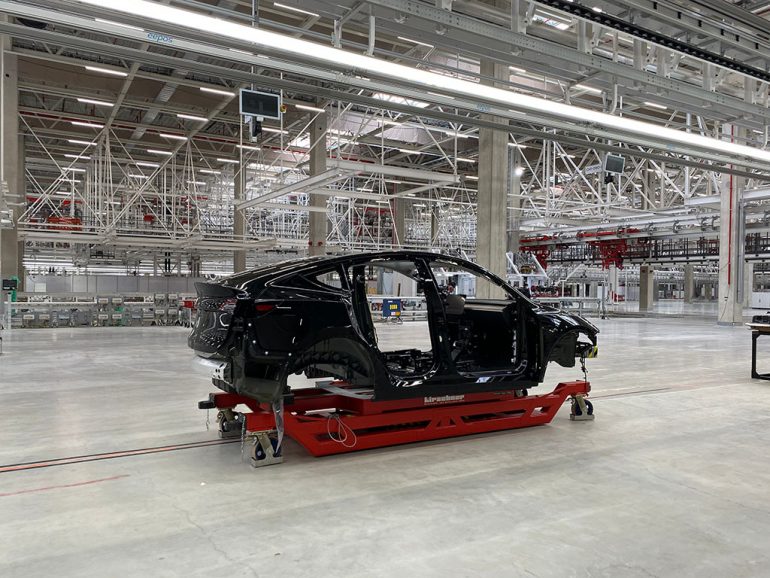
Tesla, under the visionary leadership of Elon Musk, is on the brink of revolutionizing the electric vehicle (EV) manufacturing landscape. The company has leveraged a combination of groundbreaking innovations to usher in a new era of EV production, aimed at significantly reducing costs. This bold move is driven by Tesla’s commitment to advancing its “unboxed” manufacturing strategy, which forms a crucial part of its ambitious plan to flood the market with more affordable EVs while maintaining profitability.
One of the key innovations leading this transformation is Tesla’s pioneering use of enormous hydraulic presses, exerting between 6,000 to 9,000 tons of clamping pressure. These presses are instrumental in shaping the front and rear structures of the Model Y through a revolutionary process known as “gigacasting.” This process has not only streamlined production but also left competitors scrambling to catch up.
Also, don’t forget that you can get discounted new car pricing with a free quote through qualified local dealer partners.
In a quest to expand its lead in the EV market, Tesla is now closing in on a game-changing innovation. This innovation could enable the company to die-cast almost the entire complex underbody of an EV in a single piece, as opposed to the conventional approach involving around 400 individual parts. This advanced manufacturing technique is at the core of Tesla’s unboxed strategy, a plan conceived by Musk to produce millions of more affordable EVs in the coming decade while ensuring profitability.
Although Tesla has disclosed the concept of producing large sub-assemblies simultaneously and assembling them, the exact nature and composition of these modular blocks remain shrouded in speculation. Terry Woychowski, President of Caresoft Global and a seasoned veteran of the automotive industry, acknowledges the transformative potential of this approach, stating, “It is an enabler on steroids. It has a huge implication for the industry, but it’s a very challenging task.” Casting large and intricate structures is an inherently complex endeavor.
What sets Tesla’s approach apart are the new design and manufacturing techniques, kept under wraps until now, which could enable the company to develop a car from scratch within a remarkably short timeframe of 18 to 24 months, while most competitors currently require three to four years.
The central idea revolves around creating a single large frame that combines the front and rear sections with the middle underbody, housing the battery. This innovation could potentially be applied to Tesla’s forthcoming small EV, targeted to have a price tag of $25,000 by the mid-2020s. The decision regarding the feasibility of die-casting the platform in one piece is imminent, and while it may evolve during the design validation process, its implications are monumental.
Tesla’s breakthrough in gigacasting primarily hinges on the design and testing of massive molds for such a substantial part, and how these molds can incorporate hollow subframes with internal ribs, reducing weight and enhancing crash safety. These innovations, developed by specialists across Britain, Germany, Japan, and the United States, involve 3D printing and industrial sand. The adoption of these advanced techniques opens the door to greater flexibility in the design process and reduces the cost of design validation significantly.
One of the hurdles Tesla had to overcome was the difference in behavior between aluminum alloys used in sand and metal molds. To address this, casting specialists developed special alloys, refined the cooling process for molten alloys, and introduced post-production heat treatment.
Tesla’s forthcoming small cars, designed for personal use and potential use in a robotaxi fleet, are characterized by a simpler underbody design, making them ideal candidates for one-piece gigacasting. These vehicles lack the extended front and rear sections commonly found in larger cars, resembling a streamlined battery tray with small wings at both ends.
Nonetheless, Tesla faces a critical decision regarding the type of gigapress to employ for one-piece casting, which will impact the complexity of the car frame. To manufacture such large body parts at speed, Tesla would need larger gigapresses with massive clamping power, potentially necessitating larger factory buildings and incurring significant costs. The choice between high-pressure presses, which boost productivity, and slow alloy injection presses, favored for quality and versatility, remains a critical decision point for the company.
Tesla’s relentless pursuit of innovation in EV manufacturing, including gigacasting and advanced casting techniques, promises to reshape the industry’s landscape. As the company continues to push the boundaries of what is possible in EV production, the automotive world watches with bated breath to see how these developments will further propel the electric vehicle revolution.
Source: Reuters